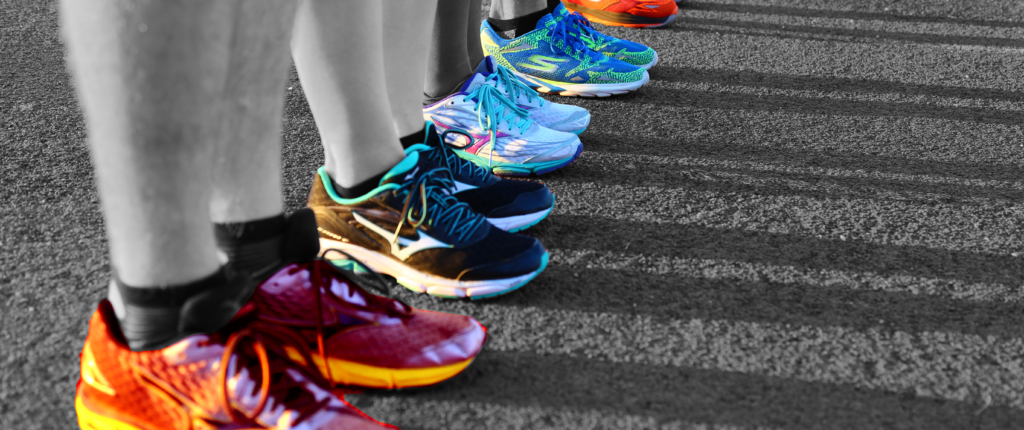Master open water swim panic with these 10 strategies. Embrace the water, find rhythm, visualize success, train with others, and more. Dive in confidently for triathlon success!
Tag Archive for: tips
“Mind over matter.” “If you can believe it, you can achieve it.” Hokey catchphrases or the real deal?
I say they’re the real deal! As a 30-something mom who loves multi-sport, I know perception turns to reality. Given the importance of having a positive mindset during the training, here are a few personal mantras and go tos that keep me kicking, pedaling, and jogging ahead, one foot in front of the other.
Find the Joy
Training should be fun. F-U-N. Luckily, I am an hour away from quiet country backroads. Once or twice a month, I make the drive to train out in that area, so I can take in new sights like horses, cows, and wildflowers. A change of scenery keeps training exciting.
For me, those quiet early hours or few miles of solitude set me up for the rest of the day. In a loud world of constant online and in-person distraction, 60 minutes of uninterrupted think time are always appreciated for getting my mindset centered.
If silence is not what I am craving, I appreciate a new playlist- will run for new tunes! Ever been jogging then bust a move at a crosswalk? It’s fun!
And some days, company is key. If I can talk my non-triathlon husband into a few bike miles with me, even better. Find ways to incorporate your family, warm ups and cool downs included. Try stretching with a toddler on your back— hip opening.
Movement is the Gift
If I ever feel stuck in the never ending hamster wheel of training— looking at you long run, I shift perspective. Think back to an injury. If you cannot recall one, you are likely very young, or have yet to start training. Life happens. Shoot, I have broken a pinky toe on a coffee table. Nothing like a setback to remind myself that movement and a healthy body should never be taken for granted.
Race Day is Coming!
Did you sign up yet? I say, do it, then tell 3 people. Make it a definite date, and stay positive. When I feel negativity or nerves creeping in, I reframe it. Race day is the party- the payoff. The icing on the training cake- and a giant celebration of every hard effort and sacrifice it takes to get there. You are worth it, and you can do it! And remember, tri races are like potato chips- you will never have just one.
Keep these ideas in your back pocket for the next time your mindset could use some re-aligning and keep chugging along, because race day will be here before you know it!
Written By: Heather Henley, Kerrville Tri Ambassador
The competitive nature of triathlons and the amount of physical effort it requires brings drastic changes in people who participate. Triathlon training is a life-changing experience as it reshapes and enhances multiple aspects of an individual’s life.
Let’s discuss how triathlon training can be beneficial for your physical, mental, and spiritual well-being:
Perfect workout regime
Triathlon training proves to be an excellent full-body workout regime. The cross-modal training for a triathlon involves intense exercise for your muscles. While swimming tones muscles of your upper body, cycling and running strengthen your lower body.
The best way to lose weight
The passion-driven training helps you to burn unhealthy body fat. Consequently, you lose weight in a natural way. Triathlon training makes you fitter and strengthens your muscles as well.
Feel energetic
The rise in physical activity in your life will boost your overall energy level. It will augment your physical wellness. Training for triathlon aids you in reestablishing your connection with your body. You become full of positive energy and start to feel productive every day.
Amazing health benefits
Triathlon training is known for its preventive and curative effect on various lifestyle-related ailments. There are numerous anecdotes of people gaining relief from heart diseases, diabetes, anxiety, obesity, and hypertension by going through triathlon training sessions. The rigorous cross-training keeps you physically and mentally healthy.
Gain confidence
Triathlon is an interesting but challenging sport. Finishing each triathlon event gives you a sense of achievement. This in turn makes you feel confident about yourself.
Handle stress better than before
Continuous exposure to physical activity and a competitive environment makes you resilient. Trainees learn the art of staying composed in stressful situations. This art is immensely helpful even beyond the racecourse of the triathlon.
Stay motivated
The sense of achievement that comes with triathlon training also helps you to stay motivated. You can do several activities while training for a triathlon instead of sticking to a constant regime. This never lets you feel bored and gets you going.
Be an inspiration for others
You can bring positive changes in the lives of those around you. They may get inspired by your journey of triathlon training.
Sense of fulfillment
Training in triathlon makes you feel like you are on a mission. It enables you to stay focused and happy. The excitement and competitive spirit of the triathlon enhance the sense of purpose.
Triathlon training fills you with positivity by improving your physical and mental health. The extensive training develops a sense of responsibility, leadership quality and time management skills. It is a door of opportunities to understand yourself and have a life-changing experience to make yourself the best.
Follow our advice to get better at hydrating while cycling
If you’re new to cycling, one of the challenges to get accustomed to is knowing how to drink water while peddling. Just as there is skill needed to balance, ride curves, and pump uphills, technique is needed to hydrate without losing your balance and falling off your bike. Here are some tips for hydrating while cycling.
Use a squirt-top bottle instead of a cap bottle
A water bottle with a cap requires you to twist it open, which is cumbersome to do with one hand on a bike. When it comes to squirt-top bottles, you can simply use your teeth to open the valve and start drinking with one hand as you control your bike with the other. The convenience a squirt-top bottle offers during cycling allows you to focus on the course more and avoid any accident.
Make use of the bottle cage on your bike
To carry water on the road, you can use a bottle cage on your bike. The bottle cage can be installed between the bars, on the frame, or near the saddle to help you reach your drink with zero fuss. Here are the pros and cons of each bottle cage.
Aero Bottle Cage
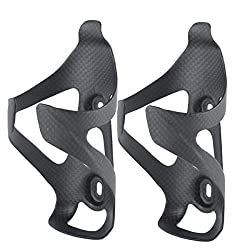 This type of cage
This type of cage is designed so that it can be attached to multiple parts of the bike frame. Most other cages can only be mounted to the frame.
Pros
– easiest to access
– option to install it either vertical or horizontal
– using horizontal bottles at the front can decrease aerodynamic drag
Cons
– poor aerodynamics compared to other cages
– using vertical bottles can cause even higher aerodynamic drag.
Bike Frame Cage
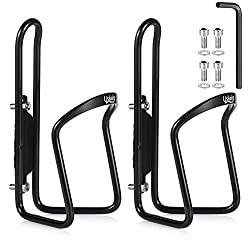 These are very common bottle holders
These are very common bottle holders that can be placed on the frame, seat post, or handlebars.
Pros
– slim aero bottles on the down tube are less affected by drag and side wind.
Cons
– intermediate aerodynamic drag
– large frame-mounted bottles are expensive and difficult to clean.
Rear Hydration System
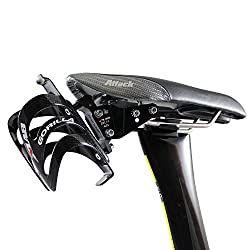 This is an aerodynamic bottle that is mounted behind the seat post
This is an aerodynamic bottle that is mounted behind the seat post. These are more so used by competitive triathletes partaking in very long distances.
Pros
– best choice in terms of aerodynamics
– least affected by side wind
Cons
– requires a cage with a strong grip to prevent bottle-launching
– must be made of a favorable material to oppose side sway
Take advantage of the straight-aways
Think about when the ideal time to take a sip is and be ready to do so. Trying to pull the water bottle out on curves is much more challenging, so wait until the trail is flat and straight to get your drink.
Practice, Practice, Practice
Ride up and down your street over and over and practice. Pull your water bottle out of the cage, take a sip, then put it back while moving forward. Start off slow and pick up speed as you get more comfortable.
Pro Tip: Avoid quenching your thirst in one go
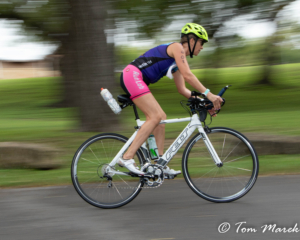 Exerting your body through exercise causes dehydration which makes you thirsty. Despite your desire to rapidly quench your thirst it’s important to not drink too much. It can be counterproductive and negatively affect your performance. It is best to avoid drinking mouthfuls and only take a few sips occasionally. You can hydrate yourself effectively without running the risk of drinking too much.
Exerting your body through exercise causes dehydration which makes you thirsty. Despite your desire to rapidly quench your thirst it’s important to not drink too much. It can be counterproductive and negatively affect your performance. It is best to avoid drinking mouthfuls and only take a few sips occasionally. You can hydrate yourself effectively without running the risk of drinking too much.
To make sure you do not run yourself dry, you should consume around 600-900 ml of water, per hour, during a triathlon, in addition to other nutritional needs. Although triathlons will have water available in transition and on the run course, not all triathlons provide an aid station on the bike course. Make sure the water bottle(s) on your bike are full so you don’t run out of water.
Hydrating while cycling can be tricky if you’re not used to it. With a secure bottle cage and lots of practice, you’ll be able to master this skill in no time.
Avoid Bonking & Keep From Blowing Up
What is bonking? Bonking is when you run out of energy to complete your event. Like a car running out of gas 10 miles into a 20-mile trip. You have no fuel to continue. What is blowing up? Blowing up is starting way too fast or maintaining too high of a pace at different points of your event, which can lead to surpassing your lactate threshold & cramping causing you to stop or slow down. Like if you just put the pedal to the floor in your car and blow your gaskets or transmission. You still have plenty of fuel, but you broke other parts of your car. If you struggle with this, keep reading to learn how to avoid the bonk and prevent from blowing up.
To keep it simple, here are the top tips to Avoid Bonking and Keep from Blowing Up
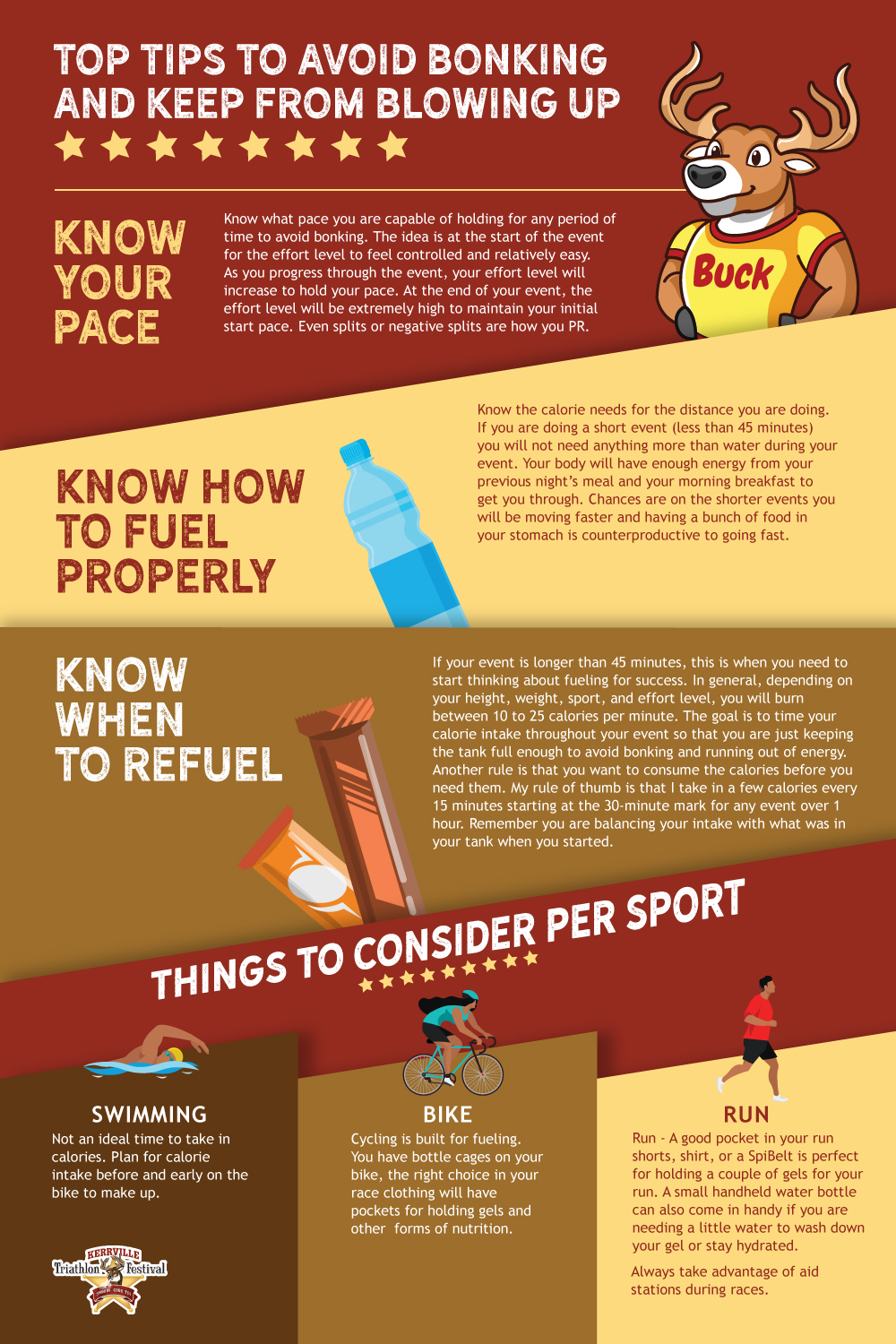 Know Your Pace. Know what pace you are capable of holding for any period of time to avoid bonking. The idea is at the start of the event for the effort level to feel controlled and relatively easy. As you progress through the event, your effort level will increase to hold your pace. At the end of your event, the effort level will be extremely high to maintain your initial start pace. Even splits or negative splits are how you PR.
Know Your Pace. Know what pace you are capable of holding for any period of time to avoid bonking. The idea is at the start of the event for the effort level to feel controlled and relatively easy. As you progress through the event, your effort level will increase to hold your pace. At the end of your event, the effort level will be extremely high to maintain your initial start pace. Even splits or negative splits are how you PR. - Know How to Fuel Properly. Know the calorie needs for the distance you are doing. If you are doing a short event (less than 45 minutes) you will not need anything more than water during your event. Your body will have enough energy from your previous night’s meal and your morning breakfast to get you through. Chances are on the shorter events you will be moving faster and having a bunch of food in your stomach is counterproductive to going fast.
- Know When to Refuel. If your event is longer than 45 minutes, this is when you need to start thinking about fueling for success. In general, depending on your height, weight, sport, and effort level, you will burn between 10 to 25 calories per minute. The goal is to time your calorie intake throughout your event so that you are just keeping the tank full enough to avoid bonking and running out of energy. Another rule is that you want to consume the calories before you need them. My rule of thumb is that I take in a few calories every 15 minutes starting at the 30-minute mark for any event over 1 hour. Remember you are balancing your intake with what was in your tank when you started.
Things to consider per sport
- Swimming. Swimming is not the ideal sport for taking in calories during a triathlon. When you are completing a tri, you need to consider calorie-intake into account and be prepared to start fueling early on the bike to avoid bonking.
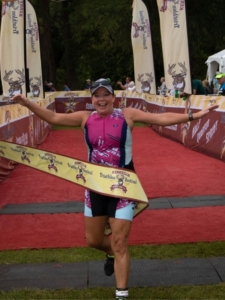 Cycling. Cycling is built for fueling. You have bottle cages on your bike, the right choice in your race clothing will have pockets for holding gels and other forms of nutrition. There are also tons of other equipment you can add to your bike to pretty much carry as much as you want. One key is to use the aid stations on course so that you are not carrying too much. Why spend a ton of money on an 18-pound bike when you are going to carry 3 to 6 pounds of nutrition? Learning how to take a bottle hand up or even stop quickly at an aid station to make sure you have what you need is important and worth every second that you might think you are losing by just blowing by the aid station without refueling. Items we recommend consuming on the bike: water, fluids with calories, gels, chews, and bars.
Cycling. Cycling is built for fueling. You have bottle cages on your bike, the right choice in your race clothing will have pockets for holding gels and other forms of nutrition. There are also tons of other equipment you can add to your bike to pretty much carry as much as you want. One key is to use the aid stations on course so that you are not carrying too much. Why spend a ton of money on an 18-pound bike when you are going to carry 3 to 6 pounds of nutrition? Learning how to take a bottle hand up or even stop quickly at an aid station to make sure you have what you need is important and worth every second that you might think you are losing by just blowing by the aid station without refueling. Items we recommend consuming on the bike: water, fluids with calories, gels, chews, and bars.- Running. A good pocket in your run shorts, shirt, or a SpiBelt is perfect for holding a couple of gels for your run. A small handheld water bottle can also come in handy if you are needing a little water to wash down your gel or stay hydrated. Aid stations are also the key for runners. Knowing the frequency of the aid stations and what they will be supplied with before the event will help you come up with the proper nutrition plan on the run. Items I recommend consuming while running: water, fluids with calories, gels, and chews.

To sum it up, what you need to do to avoid bonking is, know your body (pace), know the event (what nutrition do they offer on course), have a plan to carry additional fuel, and then practice with different amounts and mixtures of nutrition at different paces until you have the perfect plan. This will all vary based on the type and length of your event, so be sure to use these tips during your Kerrville Tri training. After all, practice makes perfect!
Don’t let your tri training mess up your do! Here are some quick tips to protect and prevent damage to your hair during your swim training
Chlorine is very damaging to your hair because it strips your hair of its natural oils, making it easier for your hair to become dry and break off or split at the ends. Keep your hairdo looking brand new for as long as possible when you use these tips to prevent damage to your hair during your training for Kerrville Tri!
Before
1. Wet Your Hair
Wetting your hair before you get in the pool will minimize the amount of chlorine and other chemicals your hair will absorb.
2. Protect Your Hair
Take it a step further by putting a protectant in your hair before you hop in the pool! Putting a protectant, such as coconut oil, on before prevents your hair from soaking up the chemicals in the water, while also moisturizing your hair.
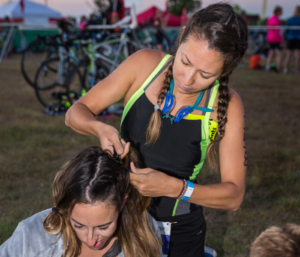
3. Wear a Swim Cap
Wearing a swim cap during your swim training is the best way to prevent chlorine from soaking into your hair. This method to prevent hair damage is very effective and it’s reusable and inexpensive.
4. Style Your Hair
If a swim cap isn’t for you, find a quick and easy way to style your hair before your workouts, such as a braid or bun, to keep your hair from getting tangled in the pool.
Your hair is bound to get some exposure to the chlorine. Follow these steps to prevent further damage to your hair after your pool session.
After
1. Rinse Immediately
After getting out of the pool, you’ll want to rinse your hair right away. You don’t have to give your hair a full wash, but it’s crucial to rinse the pool water from your hair to stop any future damage from happening.
2. Comb Gently
Your hair will most likely be tangly from your swim. Be sure to brush your hair gently to prevent the ends from breaking off! Use a leave-in conditioner or detangling spray if you need to.
3. Deep Condition
You will want to put a clarifying, deep conditioner in your hair once a week, or every 4 to 5 workouts, depending on how often you hit the pool. This will get rid of any hidden chlorine deposits throughout the hair to keep your hair looking healthy for as long as possible.
We often forget or don’t think about how damaging chlorine really is during all the pool training that leads up to your tri. Protect your hair and save yourself some money when you use these tips to protect your hair during your swim training while preparing for your upcoming tri!
Think you can skip training for the swim for your next tri? Not so fast!
You’re an ok swimmer so you don’t feel like you should allot a bunch of time training for the swim. Fast forward to the morning of your tri, add in race day elements – open water, other athletes, and no lanes to keep you in check – it’s no wonder why even seasoned triathletes may face panic during the swim. Know the importance of swim training with 5 reasons why you shouldn’t ignore swim training for your upcoming triathlon.
1. Helps Prevent Injury
Getting your body accustomed to handle the first leg of the tri is crucial. Swimming is a low-intensity, low-impact workout that will improve your overall flexibility, heart and lung capacity. Developing this during your training will prevent any unexpected incidents on race day. Train for the distance you are going to swim in your upcoming tri. Start slow and work your way up to this distance during your workouts. You can always slow down and take it easy on the bike and run legs, but during the intensity and commotion of the swim, your options are limited. For safety reasons, you cannot complete the race if you are unable to complete the swim portion. Therefore, you should practice floating on your back and practice a safety stroke as a backup plan if you start to feel tired or get frantic during the swim.
2. Avoid Swimming Further Than You Have To
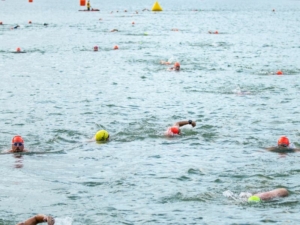
For those who have done most of your training in a pool, you are used to having a guide to keep you swimming in a straight line. If you don’t practice sighting during your training, you’ll most likely end up zig-zagging between the buoys, thus adding to the distance you have to swim on race morning. Don’t count on following the person in front of you. Sight regularly throughout the swim course to make sure you stay on the correct side of the buoys. Practicing sighting is key to avoid swimming off course during your tri.
3. Good Cardiovascular Activity
Swimming is a great aerobic exercise that will improve your cardiovascular fitness and overall health. It’s easy on your joints and is a perfect low-impact cardio exercise that can help reduce the risk of heart disease, high blood pressure, and stroke. Choose a training plan that focuses on improving your swim technique to reserve your energy for the remaining legs of the race. Also, establishing a good technique before the race will make you more efficient in the water on race day.
4. Strengthen Your Legs
Leg strength can make or break a race, so don’t make the mistake of neglecting leg work in the pool. If you haven’t spent much time in the water during your training, your legs may feel weak after completing the swim portion. To avoid feeling weak throughout the bike and run portion, use various swimming workouts to strengthen your legs during your training. The resistance from the water will strengthen your legs more than running or cycling alone. Incorporate kick sets into your swim training plan to ensure you have trained for your distance properly. Pro tip: As you near the exit swim, start kicking your legs a little stronger to get the blood circulating into your legs again to prepare for the run into transition.
5. Calm Pre-Race Nerves
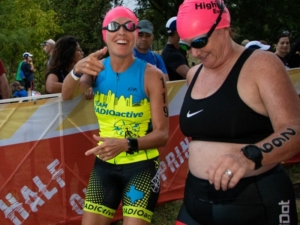
Despite all your training, things can go awry when you factor in hundreds of other athletes into the mix. Nerves on race morning can get pretty overwhelming. Especially if this is your first triathlon. Even with a time trial start, swimming with so many people of all different skill levels can unnerve a highly skilled swimmer. You need to build your confidence in the water before the race. Most training takes place in a pool, but try joining a local tri club or a Masters Swimming Program to get the experience of swimming in open water with other athletes. Pro tip: Get out and do a mock swim so there are no surprises for your open-water swim.
It is common for athletes to dread the first discipline of a tri. Preparing for this during your training will eliminate any uncertainties you have before you dive into the swim start. Whether you’re a novice swimmer or trying to go from a good swimmer to a great swimmer, training is key to a good performance on race day. So don’t hurt yourself by ignoring swim training for your upcoming tri! Grab your gear and head to the water.
Get the most out of your running shoes by knowing how to select the best ones and the replacement timeline for them
When it comes to running, the shoe you choose will greatly impact your body and running technique. Learn what type of shoe will benefit you most in the long run by using this article for how to pick out your running shoes, what type best suits you, and when it’s time for a new pair!
written by Dr. Kimberly Davis, RunLab™
HOW OFTEN DO I NEED NEW SHOES?
Probably more often than you think. Even if you have managed to achieve sound biomechanics (rare), are extremely lightweight, and a low mileage runner, it is still important to remember that your shoes have a shelf life. Those sweet (rad?) neon and splatter-paint Nike knock-offs you bought for $39.99 from TinyHandsTinyPrices.com may look really cool, but they probably aren’t doing you any favors from an injury prevention standpoint. Most people wait until they start to notice nagging pains before they think to replace their shoes, instead of doing it before the issues pop up.
[bctt tweet=”EVA foam begins to harden after 1-1.5 years, meaning that when you buy older model shoes on clearance or online it is possible for them to be “worn out” before you ever run in them.” username=”kerrvilletri”]
Most runners should replace their shoes every 300-500 miles depending on the weight of the runner and the efficiency of their mechanics. This means every 5-6 months for the average runner and every 2-3 months for the higher mileage runner. This is assuming you ONLY RUN in your running shoes, not wear them to work or to the gym.
WHAT ABOUT ROTATING THROUGH SHOES?
I am a huge fan of this concept. Not only does it allow your shoes time between runs for the foam to “bounce back”, but different types of shoes give you different feedback from the ground, and in my opinion, this is always a good thing from a neuromuscular standpoint. Your body adapts very quickly to a learned stimulus. By giving it different signals, you are forcing it to constantly respond to outside stimuli instead of just “going through the motions” with learned patterns. I personally rotate through several shoes depending on the type of run and how fatigued my body is, and I find it works very well for keeping my body engaged with what is going on between my foot and the ground. If you would like some guidance stop by and chat. Everyone that works at RunLab™ is a dedicated runner and we love talking shop.
HOW DO I CHOOSE THE RIGHT SHOE(S)?
If you answered: “Well obviously, I choose the shoes that will match my tutu for the Goofy Challenge”, then you, my friend, could probably get a job in a number of running retail stores…but I digress.
Choosing the right shoe is much more complicated than most people think IF you have suboptimal structure, range-of-motion, and/or biomechanics, which most non-elite runners (and even many elite runners) are challenged with. “How do I choose the right shoe” is the eternal question that every runner (and shoe company, and retail employee) wishes had an easy answer, but at the end of the day…it doesn’t. At RunLab™, we feel very strongly that it isn’t so much about the shoe as it is about the foot that inhabits the shoe (and the knee and the hip and the body that live above the foot and for some reason get left out of most types of “gait analysis” done in shoe stores). Most elite runners with sound biomechanics can run in almost anything they want to run in within a certain range, typically avoiding extreme stability in most cases. They aren’t great runners BECAUSE of the shoe. They are great runners because of the work they have put in on the strength side, and often because of the genetic gift they have been given on the structural side. Back to the question. First and foremost, if a shoe doesn’t feel good in the store, it won’t feel any better when you run.
STOP CHOOSING SHOES BASED ON COLOR!
Base your choice on what works with your structure, goals, foot shape, etc. If you fall outside the “norm” structurally, meaning you have bunions, very high or very flat arches, knock knees, are bowlegged, have retroverted or anteverted hips, super tight hamstrings or calves, etc., or if you have a history of injuries, or trouble finding shoes that work for you, get a movement analysis & gait evaluation. And I don’t mean the kind where somebody watches you run for 10 seconds down the street, looks at your foot/ankle, and then starts talking about how much or little you pronate or supinate. That isn’t a gait evaluation folks! A good gait evaluation should look at your entire body from multiple angles, ideally, both in shoes and barefoot, and should factor in what is happening with your unique structure, range-of-motion, goals, strengths, and limiters. This is not something most people have expertise in doing well.
Think of it in bike-fit terms, you can get your saddle height adjusted, OR you can go through a lengthy process that looks at all the necessary angles and takes your individual needs, foot position, femur length, tibia length, reach, etc. into account. Both of these things might be referred to as a “bike-fit” but one of them clearly takes your unique structural and functional makeup into account and requires expertise in biomechanics to really fit you properly. Movement analysis and gait evaluation is the same way. Remember: understanding what could go wrong down the road through thoroughly understanding your mechanics is a heck of a lot cheaper than the rehab to fix the issue when you break. Just sayin’…
IN SUMMARY:
- Replace your shoes early and often, more often the higher you go in mileage and before you start to notice pain.
- Stop picking shoes based on color! Seriously. Did I really need to say that? Yes. Yes, I did. Stop doing it.
- Choose your shoe stores wisely, we can guide you if you need help.
- When someone calls you a “pronator” or a “supinator” and then attempts to “fix” the issue with a shoe, this person doesn’t under biomechanics. Be wary.
- A Movement Analysis and Gait Evaluation looks at the whole body and doesn’t just take 30 seconds. If you have structural or injury issues, it’s worth getting it done by experts (I might know some people!)
- The shoes don’t fit if your heels slide, or if your toes are pinched.
- If part of your foot is hanging over the sole of the shoe, it doesn’t fit.
- If you hate the color…it still might fit! See how you tried to forget what we talked about already?!
ABOUT DR. DAVIS
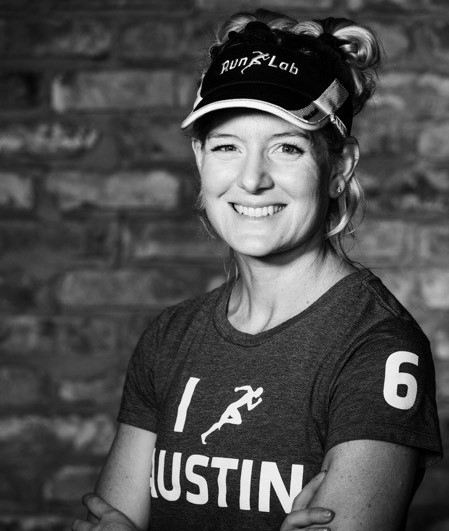
Dr. Kimberly Davis is the Founder & CEO of RunLab™, a Movement Analysis and Gait Evaluation company headquartered in Austin, Texas that provides runners anywhere in the country access to comprehensive gait evaluation services through www.runlab.us.
Recognizing a lack of consistency and quality in gait analysis across the country, Dr. Davis launches RunLab.us in 2018 as a means for runners to access her industry-leading gait team from anywhere in the United States.
For more information about the RunLab™ team, please visit WWW.RUNLABAUSTIN.COM
For gait evaluation services outside the Austin area, please visit WWW.RUNLAB.US


